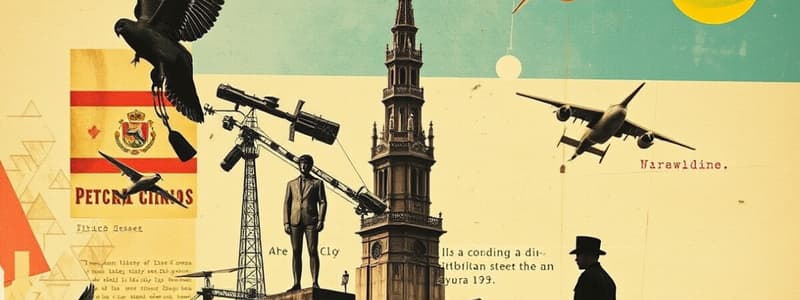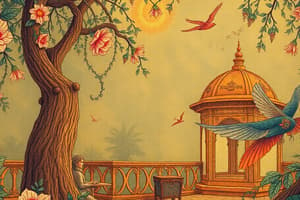Podcast
Questions and Answers
What is the vernacular language in the Philippines?
What is the vernacular language in the Philippines?
Filipino
The three goals or reasons why Spaniards came to the Philippines are Grace or God, Gold, and ______.
The three goals or reasons why Spaniards came to the Philippines are Grace or God, Gold, and ______.
Governance
Which of the following are types of Spaniards?
Which of the following are types of Spaniards?
- Peninsulares (correct)
- Filipinos
- Insulares (correct)
- Guatemalans
Who is known as the Father of Katipunan?
Who is known as the Father of Katipunan?
What type of literary work is 'Florante at Laura'?
What type of literary work is 'Florante at Laura'?
José Rizal wrote the novel 'Noli Me Tangere'.
José Rizal wrote the novel 'Noli Me Tangere'.
Which of the following is a notable work of Paz Marquez Benitez?
Which of the following is a notable work of Paz Marquez Benitez?
Match the following notable writers with their contribution:
Match the following notable writers with their contribution:
What was the first book published in the Philippines?
What was the first book published in the Philippines?
Which group of missionaries included the Jesuits?
Which group of missionaries included the Jesuits?
Flashcards are hidden until you start studying
Study Notes
Vernacular Language: Filipino - Katutubong Wika
- Filipino languages evolved during the pre-colonial period in the Philippines.
- The Spanish colonial era is divided into two periods; Early Spanish (1521 - 1565) and the Revolutionary Period (1565 - 1898).
3Gs (Reasons for Spanish Arrival in the Philippines)
- Grace or God: Religious mission to spread Christianity.
- Gold: Economic exploitation and resource extraction.
- Governance: Establishment of political control.
Missionary Groups
- Notable missionary groups included Augustinians, Franciscans, Jesuits, Dominicans, and Augustinian Recollects.
Social Structure
- Two types of Spaniards distinguished:
- Peninsulares: Spaniards born in Spain.
- Insulares: Spaniards born in the Philippines.
- Governor Narciso Claverio encouraged Filipinos to adopt Spanish names.
Literature Forms
- Awit: Poetic form consisting of 12 syllables per line.
- Korido: Poetic form consisting of 14 syllables per line.
Key Figures in the Revolutionary Period
- Emilio Jacinto: Known as the "Brain of Katipunan."
- Andres Bonifacio: Recognized as the "Father of Katipunan."
- Emilio Aguinaldo: First President of the Philippines, involved in Katipunan's betrayal.
La Solidaridad
- A newspaper focused on exposing Spanish injustices, serving as a voice for the Filipino reform movement.
Notable Publications
- Doctrina Cristiana: A religious text in Spanish about Christianity.
- Paz Marquez Benitez: First Filipino woman to publish a short story collection, "Dead Stars," in 1925.
- Lope K. Santos: A prominent figure in Filipino grammar, known as "Ama ng Balarila."
Printing and Literature Development
- Introduction of Xylographic Press by Dominicans led to enhanced publication of religious materials.
- Tagalog versifiers called Ladinos produced works centered around morality and religion.
- Diaryong Tagalog (1882): A Spanish-Tagalog newspaper featuring Filipino writings, advocating for reforms.
Emergence of Other Literary Forms
- Folk Songs: Modified to fit Filipino contexts, retaining cultural significance.
- Recreational Plays: Influenced by Spanish poetic styles, performed during the colonial era.
- Notable forms include Cenaculo, Carillo, Zarzuela, Moro-Moro, Balagtasan, Duplo, and Karagatan.
Notable Books Published
- Nuestra Señora del Rosario: Written by Fr. Blancas de San Jose.
- Barlaan at Josaphat: First published in 1708, translated from Greek to Tagalog by Fr. Antonio de Borja.
- Urbana at Felisa: Written by Modesto de Castro, regarded as the Father of Classic Prose in Tagalog.
Noteworthy Filipino Authors
- Francisco Baltazar: Master of traditional Tagalog poetry, known for "Florante at Laura."
- Pedro Paterno: Author of the first Filipino novel, "Ninay," and a poetry collection in Spanish.
- José Rizal: National hero, writer of "Noli Me Tangere" and "El Filibusterismo," which critique Spanish authority.
- Andres Bonifacio: Prominent revolutionary, wrote “Pag-ibig sa Tinubuang Lupa.”
- Leona Florentino: Mother of Philippine Women’s Literature, multi-lingual poet with preserved works in Europe.
Studying That Suits You
Use AI to generate personalized quizzes and flashcards to suit your learning preferences.



